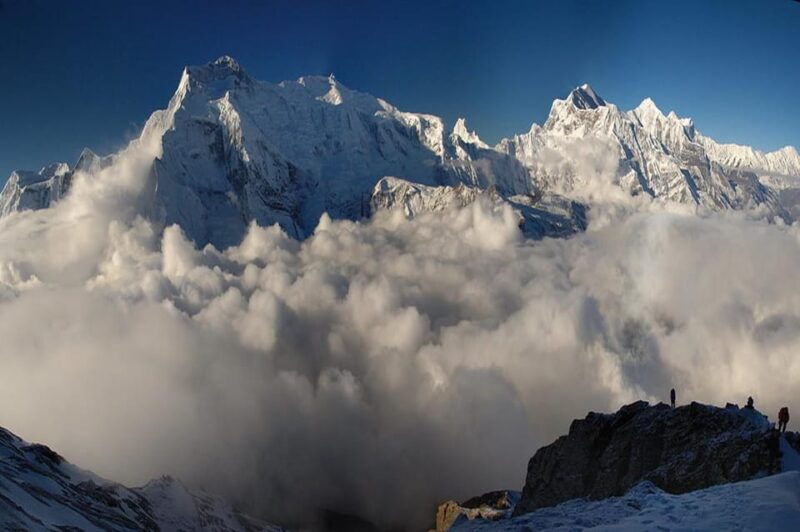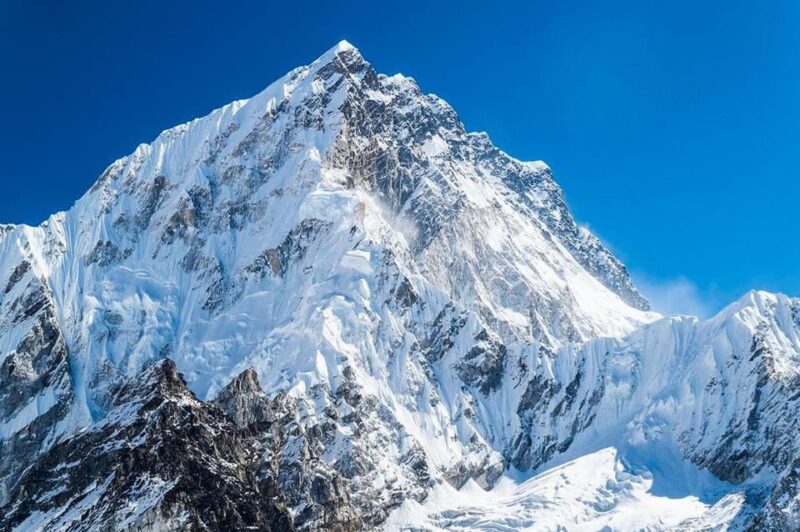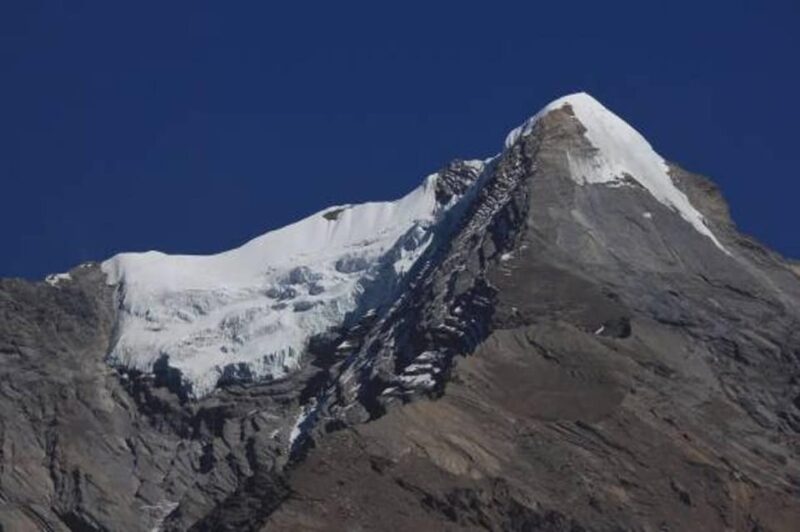Pisang Peak Climbing offers an exhilarating adventure for the avid mountaineer seeking to conquer one of Nepal’s less-traversed peaks. Standing at an impressive 6,091 meters, this challenging yet accessible summit lies nestled between the towering Annapurna I and Manaslu ranges. Trekkers can expect a well-structured itinerary that allows for proper acclimatization, culture, and the thrill of reaching the top. Whether you’re a seasoned climber or a newcomer to high-altitude expeditions, Pisang Peak’s captivating landscapes and unique cultural encounters make it a tempting proposition that’s worth considering for your next adventure.
Key Points

- Pisang Peak is a 6,091-meter mountain located in the Manang district between the Annapurna I and Manaslu ranges.
- The climbing itinerary includes a 12-hour drive to Upper Pisang, acclimatization, and a 3-4 hour trek to Base Camp and High Camp.
- The Pisang Peak Climbing package starts at $1,027.91 per person and includes essential services like climbing permits, guide, and porters.
- Highlights of the trek include cultural interactions, diverse landscapes, and stunning Himalayan vistas.
- Climbers are responsible for personal equipment, expenses, and obtaining a valid Nepal entry visa before the expedition.
Overview of Pisang Peak
Pisang Peak, also known as Jong Ri, is a popular trekking peak located in the Manang district between the towering Annapurna I and Manaslu mountains.
Standing at 6,091 meters (19,984 feet), it was first successfully climbed by a German expedition team in 1955.
The peak offers a diverse range of landscapes, cultural sites, and biodiversity, making it an adventurous climb for those seeking a 6,000-meter class peak.
Trekkers and climbers can expect to experience the stunning scenery of the Annapurna region, as well as interactions with the local Gurung and Tibetan-descended communities along the way.
You can also read our reviews of more tours and experiences in Pisang.
Itinerary Details

The itinerary for the Pisang Peak Climbing adventure begins with a lengthy drive from Kathmandu to Upper Pisang, which takes approximately 12 hours.
The following day is set aside for acclimatization at Upper Pisang, situated at an elevation of 3,700 meters.
The trek then progresses from Upper Pisang to the Pisang Peak Base Camp, covering a distance of 3-4 hours.
Ascending to the Pisang Peak High Camp at 5,400 meters takes another 3-4 hours.
The summit attempt is scheduled for the next day, with the return to the Base Camp expected to take 7-9 hours.
Pricing and Booking Information

Typically, the Pisang Peak Climbing package starts at $1,027.91 per person. Customers have the convenient option to reserve now and pay later.
On top of that, free cancellation is available up to 24 hours in advance for a full refund. The package is valid for 7 days from the first activation, providing flexibility.
The pricing includes essential services such as hotel stays, climbing permits, guides, meals, and porters. However, personal expenses like alcoholic beverages, laundry, tips, and extra sightseeing aren’t covered.
Participants are responsible for their personal accident insurance, emergency evacuation costs, and climbing gear. Plus, Nepal Entry Visa Fees apply.
Inclusions and Services
Included in the Pisang Peak Climbing package are two nights’ accommodation in a deluxe hotel in Kathmandu with breakfast, and one night in a hotel in Pokhara.
Plus, the package includes:
- Climbing permit and national park entrance fees
- Experienced climbing guide (Sherpa) for two members
- All meals during the trek and camping, including seasonal fruits
- Porters to carry member baggage (15-18 kg per person)
The package provides basic camping gear, such as sleeping bags and down jackets, if needed.
Personal expenses, accident insurance, emergency evacuation, and climbing equipment are the responsibility of participants.
More Great Tours NearbyHighlights of the Trek
Pisang Peak Climbing offers a variety of captivating highlights that make the trek a truly immersive experience. Trekkers can interact with the local Gurung and Tibetan-descended communities, gaining insights into their unique cultures and traditions.
As they traverse through the traditional villages of Chamje, Dharapani, and Chame, they’ll be enchanted by the picturesque landscapes and architectural marvels. The trek also presents opportunities to witness the region’s remarkable biodiversity, from lush alpine meadows to the towering peaks of the Annapurna and Manaslu ranges.
Throughout the journey, trekkers will be treated to stunning vistas that showcase the breathtaking natural beauty of the Nepalese Himalayas.
Personal Expenses and Gear
While the climbing package covers most essential expenses, participants are responsible for managing their personal costs. This includes items such as:
- Alcoholic beverages and snacks
- Laundry services
- Tips for the guides and porters
- Extra sightseeing or accommodation in Kathmandu
Plus, participants must procure their own personal climbing gear, including items like mountaineering boots, harnesses, and carabiners.
The organizers provide sleeping bags and down jackets if needed, but climbers should ensure they’ve the necessary specialized equipment for a safe and successful expedition on Pisang Peak.
Nepal Entry Visa Fees
Travelers to Nepal must obtain a valid entry visa before their trip.
Nepal offers several visa types, including tourist visas, business visas, and diplomatic visas. The most common for Pisang Peak climbers is the tourist visa, which can be obtained upon arrival at Tribhuvan International Airport or at a Nepali embassy/consulate prior to departure.
Tourist visas are generally valid for 15, 30, or 90 days, depending on the traveler’s needs. Visa fees vary based on nationality and duration, but typically range from $30 to $100 USD.
Climbers should ensure their visa remains valid throughout their entire stay in Nepal, as overstaying can result in penalties and difficulties at the time of departure.
Climbing Permits and Regulations
To climb Pisang Peak, adventurers must first obtain the necessary permits and understand the regulations governing the activity. A Pisang Peak climbing permit is required, which can be obtained through authorized trekking agencies.
Plus, a national park entry permit for the Annapurna Conservation Area is necessary. Climbers must also adhere to specific regulations, including:
- Adhering to prescribed routes and campsites
- Properly disposing of waste and practicing eco-friendly measures
- Respecting the local culture and customs
- Obtaining the required insurance coverage for the expedition
These permits and regulations aim to ensure the sustainability and safety of Pisang Peak climbs, allowing adventurers to enjoy the peak’s stunning landscapes while minimizing their environmental impact.
Frequently Asked Questions

What Is the Best Time of Year to Attempt Pisang Peak?
The best time to attempt Pisang Peak is during the spring (March to May) and autumn (September to November) seasons when weather conditions are mild, skies are clear, and technical challenges are manageable for experienced climbers.
What Is the Average Success Rate for Reaching the Summit?
The average success rate for reaching the summit of Pisang Peak is around 65-70%. Many factors like weather, acclimatization, and climber experience can impact the chances of successful summit attempts on this challenging 6,000-meter peak.
What Level of Mountaineering Experience Is Required for This Climb?
Pisang Peak climbing requires previous mountaineering experience and training. Climbers should be physically fit, have experience with glacier travel, and possess basic climbing skills. The peak’s altitude and technical demands make it suitable for intermediate-level climbers.
What Emergency Resources Are Available During the Expedition?
The expedition provides basic medical kits and normal emergency support. However, participants are responsible for their personal accident insurance and covering any additional emergency evacuation costs if required during the climb.
Are There Any Specific Fitness Requirements to Take on This Challenge?
Climbers should have a good fitness level, as the trek and climb require significant physical exertion. Previous mountaineering experience is recommended, and participants should be prepared for the high-altitude environment and challenging terrain encountered during the Pisang Peak expedition.
Recap
Pisang Peak Climbing offers an unparalleled opportunity for adventure seekers to conquer a challenging yet accessible peak in the heart of the Nepalese Himalayas. With a well-structured itinerary, climbers can enjoy the region’s stunning landscapes, vibrant local cultures, and the thrill of summiting this 6,091-meter peak, making it a popular choice for those seeking an unforgettable mountaineering experience.
You can check availability for your dates here:More Tour Reviews in Pisang
Not for you? Here's more things to do in Pisang we have recnetly reviewed
- 2 Best Guided Tours In Pisang
- 12 Best Hiking And Trekking Tours In Pisang
- 15 Days TilichoLake & Annapurna Circuit Trek: From Kathmandu
- Tilicho Lake & Mesokanto Pass Trek: A 14-Day Adventure
- 15 Days Annapurna Circuit & Tilicho Lake Trek From Kathmandu
- From Pokhara : 10 Day Mystical Annapurna Circuit Trek
- A 14-Day Tilicho Lake and Mesokanto Pass Trek Adventure
- Annapurna Circuit Trek
- Tilicho Lake Trek With Thorangla Pass
- From Kathmandu Budget: 8 Day Private Annapurna Circuit Trek
- Kathmandu: 11 Days Annapurna Circuit Trek With Thorong La
- Pisang Peak Peak Climbing
